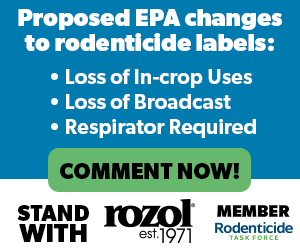Mar 8, 2023Rodenticide group seeks to minimize EPA restrictions
Almost 2,200 comments and documents have been submitted in response to an Environmental Protection Agency proposal that would limit the use of rodenticides, and who can apply them in orchards and other agricultural areas.
A 65-day comment period on the changes, known as Proposed Interim Decisions (PIDS), ended Feb. 13. The EPA, however, is still accepting emails. An industry group is encouraging growers, pesticide dealers and others affected by the restrictions to tell their story.


“Many of the limitations suggested in the (PIDs) would substantially increase costs and compliance measures on our operations and could jeopardize our ability to produce and offer fresh, safe and resource-conscious food products to consumers around the world,” according to the coalition’s letter, signed by representatives of groups that include the California Farm Bureau, California Apple Commission, California Blueberry Commission, American Pistachio Growers and California Citrus Mutual.
Affected products are brodifacoum, bromadiolone, bromethalin, chlorophacinone, cholecalciferol, difenacoum, difethialone, diphacinone, strychnine, warfarin (and its sodium salt) and zinc phosphide.
The focus on anticoagulant and acute rodenticides is a result of a registration review by EPA, a mandated process in which the agency every 15 years reviews whether a pesticide “can perform its intended function without unreasonable adverse effects on human health or the environment,” according to EPA.
The agency reported there are chlorophacinone and diphacinone products with labels that allow for loose meal bait formulations above ground via spot/scatter and broadcast treatments and below-ground treatments in burrows to cropped areas including orchards, groves, vineyards, and alfalfa.
“EPA does not have sufficient residue data to support the establishment of tolerances for chlorophacinone and diphacinone, or to demonstrate there is no plant uptake in order to make a non-food use determination,” according to the agency. The agency proposes the following restrictions necessary for chlorophacinone and diphacinone products registered for use in the sites.
For above-ground applications of loose meal bait formulation of chlorophacinone and diphacinone applied as a scatter/spot or broadcast treatment, EPA is proposing that:
- Applications cannot be made directly to food or feed crops;
- The application can only be made during the non-growth (“dormant”) period of the target crop;
- Application is made along fence lines, border areas, and buffer strips adjacent to target crops.
- EPA is proposing to prohibit aerial application to food or feed crops.
For below-ground or in-burrow use, EPA is proposing that:
- Applications must be made below-ground into the main run of the burrow; and the application can only be made during the non-growth (“dormant”) period of the target crop.
- For applications made to non-bearing crops, EPA is proposing to add a restriction for harvesting food/feed from that crop within one year of application.
The Rodenticide Task Force, an alliance of pesticide companies, is heading the effort to inform growers and encourage them to submit comments to the EPA.
“The (EPA) was under a lot of political pressure to mitigate for concerns about wildlife exposure to the rodenticides,” said Katie Swift, chairwoman of the task force and senior manager of governmental affairs at Liphatech, which manufactures Rozol and other rodenticides. “As well as that there seems to be a bizarre dynamic going on with the agency’s scientists where they have suddenly decided that the anticoagulants pose a risk to human health from the crop applications that we’ve had for 50 years.
“They did these very extreme, very broad proposed mitigations, where they are proposing to cancel the spot and broadcast applications in the orchards and are only going to allow bait stations applications,” she said.
The proposal reclassifies all rodenticides to Restricted Use Pesticides (RUP), and anyone who uses them would be required to be registered, licensed and certified.
The task force has pushed back on the EPA’s use of incident data, which are generated when anyone reports they believe a product made them ill or affected wildlife. Those reports aren’t verified or investigated.
“They have no evidence to link any of these incidents with specific products and specific use patterns,” Swift said.
Gary Hathaway, senior marketing manager of agricultural markets at Liphatech, said the requirement that workers wear an APF10 (Assigned Protection Factor) half-face respirator and chemical-resistant gloves, will be an added expense.
“If you make it incredibly inconvenient to use a product, the EPA will get their objective of less chemical load in the environment,” Hathaway said.
The Rodenticide Task Force seeks to unify the message from pesticide companies, growers and others.
“There’s no real way that a voice on behalf of the farmer can beat the noise, the pressure, that’s created by the FDA,” Hathaway said.
To comment on the proposed changes, send an e-mail to Melanie Biscoe in EPA’s pesticide re-evaluation division: [email protected]. Include the name of the active ingredient and docket number, EPA–HQ–OPP–2017–0750.
— Chris Koger, managing editor














